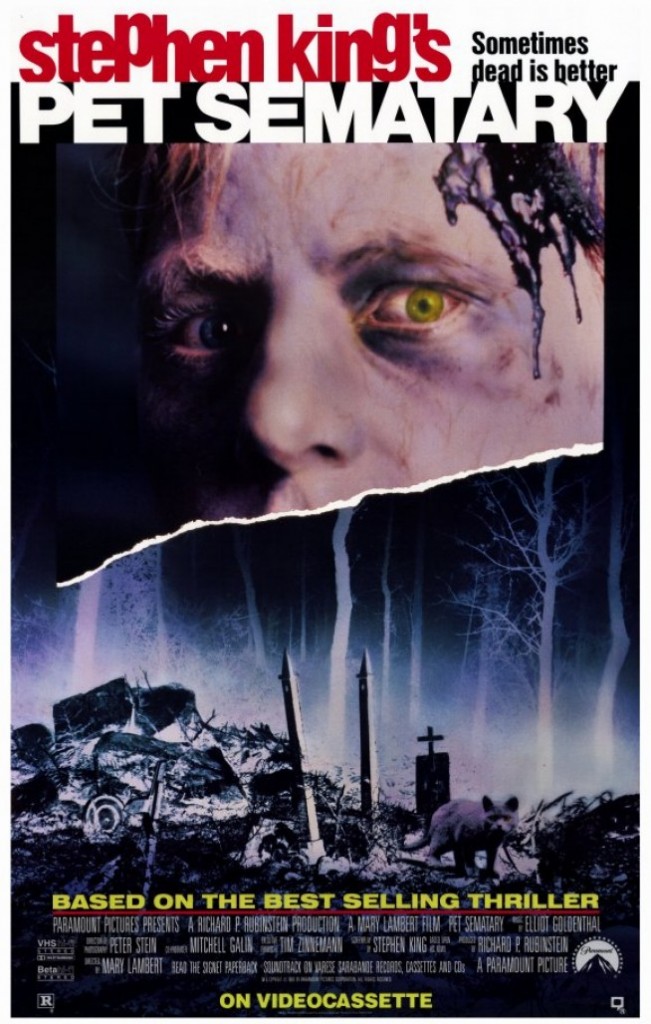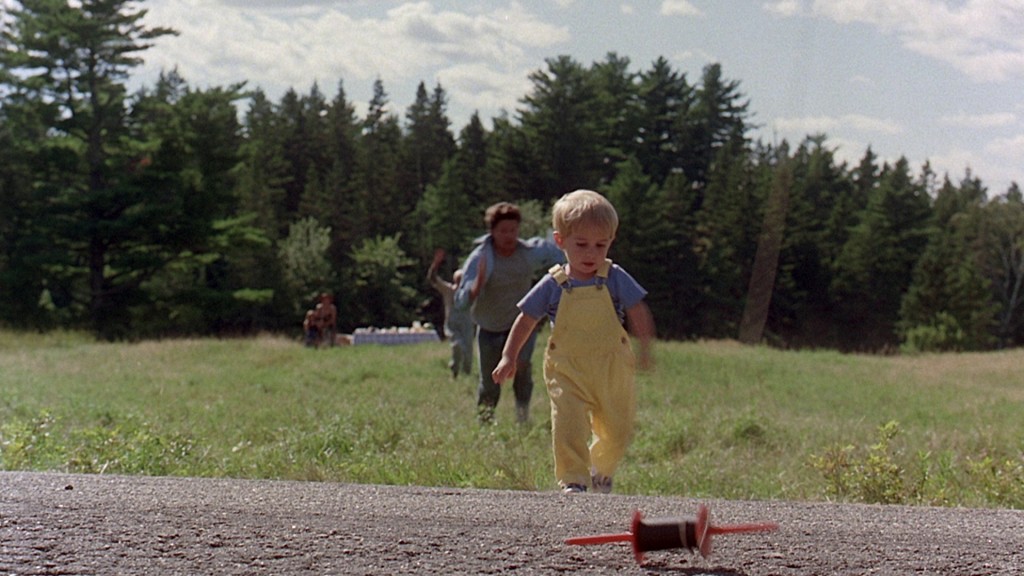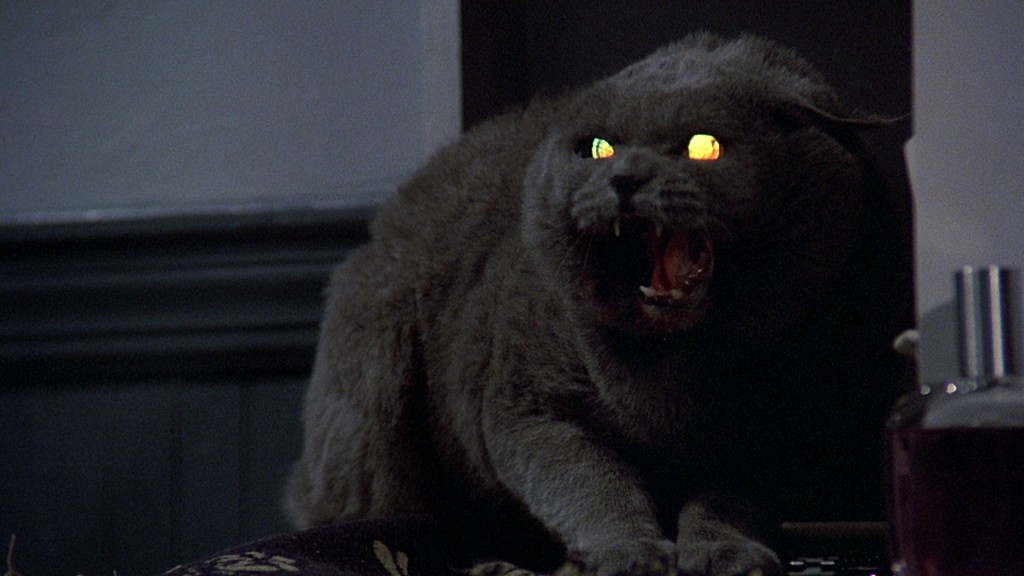It’s October. With Halloween hot on our heels, we thought it appropriate to take a look at legendary horror author Stephen King’s best, worst, and strangest translations from page to screen. Baby, can you dig your man?
I SHOULD HATE PET SEMATARY BUT I DON’T I REALLY REALLY LOVE IT.
Stephen King’s Pet Sematary is sometimes called “the scariest book ever written.” The 1989 film, written by King and directed by Mary Lambert doesn’t stand quite as high in the horror-film pantheon, but it’s well-regarded and a strong, faithful adaptation. I’ve only experienced each once, but both book and film left an indelible impression on me.
The film begins as Louis Creed (Dale Midkiff) and his wife Rachel (Denise Crosby, fresh off Star Trek) move to a small town for Louis to start a job as the head doctor at the University of Maine. The Creeds have two children, the school-age Ellie (Blaze Berdahl) and baby boy Gage (Miko Hughes), and a cat, Church. Louis immediately hits it off with his elderly neighbor, Jud (Fred Gwynne, not-as-fresh-off The Munsters). There are only two things wrong…trucks speed past the house way too fast, and there’s this creepy pet cemetery with a poorly-lettered sign a short walk away…
When Church is struck and killed, Jud, seemingly against his better judgment, tells Louis of the cemetery’s secret. Louis buries the animal in the cemetery, and before his wife and kids get home to discover the tragedy, Church returns to the house, miraculously alive again. But there’s something different about him…and more importantly, Louis now knows the secret, and must face the temptation of the Sematary if something should ever happen to one of his loved ones. As Jud tells Louis in vain, “sometimes dead is better.”
One thing that’s odd about my love for Pet Sematary is that it does a lot of things I normally hate in drama. It uses a lot of cliches that I’m either really sick of or that I just didn’t like in the first place. But somehow in this particular case, all of these elements I normally find frustrating add to what I think is one of the great modern horror stories.
1. There’s no rational explanation for the horror.
Why I Hate That: I like movies that take real things and just push one element farther, onto a next level that the human mind can no longer comprehend. Jaws takes the existing fear of random animal attack and embodies it in a relentless, indestructible form. The Shining asks what would happen if an alcoholic’s predation on his family was pushed just a little farther by the supernatural. Slasher movies are just a way to dramatize real-life attacks by serial killers. Pet Sematary, however, depicts the pouncing of a rapacious place/god/thing onto a family that can do nothing to predict or deserve it. It produces no analogy and serves no apparent purpose.
But in Pet Sematery: Well, partly it’s because the nature of evil in the film is never quite revealed, and even in the book it is delayed. But mostly it is because no matter how much vaguely defined magic King throws in, he’s more interested in the human weakness of his leads. Ultimately the story is driven by Louis Creed’s inability to accept suffering of his loved ones, so the poor definition of the supernatural is a survivable weakness.
2. Omnipotent villain with no motivation.
Why I Hate That: How can you fight omnipotence? Villains and heroes both need weaknesses to elevate a plot above the mere exercise of writer’s fiat. Even villains that cannot be fought can be outmaneuvered in some way. But Pet Sematary’s villain is the land itself, which seems able to manipulate any character at any time. Jud is a mere puppet, serving the Sematery’s purpose in every scene regardless of his pure intentions. As the final insult, it puts him to sleep at the crucial moment to prevent him from stopping Gage’s resurrection—when Gage dispatches him later it’s an afterthought. And poor Louis demonstrates that even a model of rationality will be chewed up and spat out a madman with no defense. Hell, it probably engineered Church’s and Gage’s deaths too.
But in Pet Sematery: For such a sprawling storyline, in some ways Pet Sematary is just an extended vignette. With such a strong sense of psychological horror, the hopelessness of the Creeds’ situation becomes an asset to the horror rather than a frustration.
3. Arbitrary, harsh punishments meted on the characters.
Why I Hate That: We may mock slasher tropes for all their misogyny and prudishness, but the slasher keeps on ticking because its emotional logic is flawless. All of the characters are complicit in their own destruction. Here, Louis’ culpability is itself inflicted on him by the foul graveyard, and his family is innocent to the end.
The most stunning moment in book and film is the slaughter of Gage by a random passing truck. The movie wisely veers away from the harsh, matter-of-fact, gory presentation of the book. In the film, Lambert cuts at the moment of contact between child and truck to show Gage’s kite abruptly flying away.
The sequence is based on a moment of horror that struck King himself as he saved his own child from a similar fate. But King went so far as to build everything else in the story on further events of arbitrary cruelty inflicted by fate, whether natural (Rachel’s sister Zelda’s disfiguring disease, Victor’s death by traffic accident) or supernatural (everything to do with the Sematery).
But in Pet Sematery: Life is cruel! So many things in our lives invalidate the comforting fantasy that God protects us. Pet Sematary’s genius is that it captures this feeling and forces us to experience every tightening of the screws on Louis, every undeserved crushing blow to his happiness and sanity.
4. Unrelated elements of fantasy thrown into the mix.
Why I Hate That: You know how the first Iron Man worked so well? Part of that is because at the last second, they kicked the Mandarin out of the story and built everything around the Arc Reactor that Tony built. Hollywood has long had a semi-written rule that it’s better to build fantasy around one break from reality rather than just tossing a few in there. Harry Potter is our world, but with magic. Star Trek is our world, but in the future. Back to the Future is our world, plus one time machine.
In Pet Sematery, not only is there more happening than the ills inflicted by the Sematery, but it’s not even the only supernatural game in town. For reasons unclear, Louis is haunted by the ghost of a college student he failed to save at the beginning of the story. Rather than manifesting Louis’ decency in a more subtle manner, it’s a Literal Ghost who tries and fails to pull the Creeds away from the malign graveyard. Even after enlisting the help of Ellie through her prophetic dreams, Victor fails to prevent Louis from charging headlong into damnation.
But in Pet Sematary: Ok, it’s pretty easy to imagine the book without Victor’s ghost. But the movie makes him more central and puts a little more emphasis on the idea that the Sematary is so uniquely evil and powerful that even a heaven-sent undead spirit is utterly powerless. It introduces a new kind of horror—that even characters that magically incorruptible are still impotent to save the characters that can be influenced. And the foretelling of Ellie Creed makes her into a Cassandra figure. Louis and Rachel Creed are spoon-fed all of the information they could have used to save themselves and they still fail. Thus, the brief supernatural side-plot of Ellie Creed elevates the entire story into a tragedy of Oedipal proportions.
Perhaps the final lesson of Pet Sematary is that horror doesn’t always require logic. In much the same way that a funny enough comedy can cause us to overlook any plot holes, some stories are justified by their own frightening nature. Pet Sematery fails to satisfy my analytical brain, but it hits my emotional amygdala like a lightning bolt. King does nothing better than to manifest American anxieties.
Check back all this month for more essays on Stephen King stories on screen.






